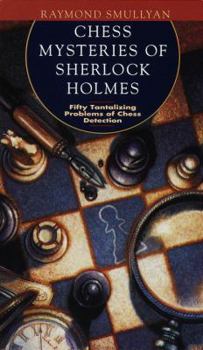The Chess Mysteries of Sherlock Holmes: Fifty Tantalizing Problems of Chess Detection
Select Format
Select Condition 
Book Overview
Join the master sleuth as he and Dr. Watson examine interrupted chess matches at clubs and country homes, examining the pieces' current positions to identify previous moves. Rather than predicting the... This description may be from another edition of this product.
Format:Paperback
Language:English
ISBN:0812923898
ISBN13:9780812923896
Release Date:September 1994
Publisher:Random House Puzzles & Games
Length:192 Pages
Weight:0.50 lbs.
Dimensions:0.5" x 5.0" x 8.5"
Customer Reviews
5 ratings
wonderful book!
Published by Thriftbooks.com User , 16 years ago
This is a book I return to every year or two. The chess problems are presented in a thoroughly engaging fashion--the Sherlock Holmes aspect gives a bit of continuity, but it isn't a crucial part of this book. Some of the problems are not too difficult, others are very complex. The book explains the solutions and the reasoning well. There are several kinds of problems in the book. Some of these--especially the earliest--ask the question "what was the previous move?" At first (and second and maybe third) glance you might conclude the position is impossible. Then you find (or look up) the solution: the ingenuity whether you solved the problem or not is always enjoyable. Other kinds of problems include questions such as "Can black castle?" There's plenty of variety in these retrograde analysis positions. Smullyan's sequel, "Chess Mysteries of the Arabian Knights", is equally worthwhile. An additional book dealing with retrograde analysis that is well worth reading is Perez-Reverte's Flanders Panel (which pays some homage to Smullyan). This is a mystery within a mystery, involving a centuries-old murder and a painting of a chess game. The art restorer finds a hidden message "Who took the knight?"--although an acceptable translation would be also "Who slew the knight?" One of the chess players was a knight, and was the murder victim. Retrograde analysis is needed to figure out which piece captured the knight, and that's just the beginning. Retrograde analysis makes for a very different kind of chess problem, and with Smullyan you know that you're reading the work of a master!
joy of discovery
Published by Thriftbooks.com User , 21 years ago
I think the 2-star reviewer misses the point of this book: it's supposed to be fun. And it is. The puzzles are pretty challenging, and it definitely helps if you play chess. You tend to notice positional abnormalities that are the bases of the problems. From there, it's just detective work.But the real treat to this book is the world the author creates. Smullyan's characters can't play chess for nuts. You should see the bizarre positions they come up with - it's as though they're making random moves. Yet this doesn't diminish their love of the game one bit. They're such gentlemen too. No one minds when Dr. Holmes interrupts to ask questions. His new friends are always polite and like nothing more than a good demostration of deductive reasoning. I wish I lived in their world.
Fascinating puzzles, but won't improve your chess
Published by Thriftbooks.com User , 23 years ago
The other reviews given below cover the contents comprehensively - I wholeheartedly agree that it is a wonderful book for those that enjoy puzzles and have a knowledge of chess. However, lest anyone believe otherwise - this book will in no way improve your chess playing skills. The puzzles are all about what happened (ie the history of moves) to bring about the current chess position (given in a diagram) on the assumption that the laws of chess have been strictly observed. There is no assumption that either side played plausibly or well to bring about the current position. Thus, the puzzles do not concern a future sequence(s) of moves that would, for example, lead to mate for black/white. This is what sets it apart from most chess puzzle books.
Retrograde analysis at its best
Published by Thriftbooks.com User , 24 years ago
Those who enjoy puzzles that require logical thinking but are bored by standard "logic puzzles" and chess problems will find this book a sheer delight. Each puzzle presents an innocuous-looking chess position and a seemingly impossible-to-answer question about it, such as, "What was White's previous move?" or "Is it legal for Black to castle now?" or "On which square must the White pawn be located?" The questions can all be answered by pure deduction; although some of the problems are in some sense "trick questions," there are no silly answers involving outright cheating of the kind commonly found in inferior puzzle books. The puzzles are fresh, original, entertaining, and deep. My only complaint is that in the first half of the book, there is no clear demarcation between the statement of the puzzle and the solution, so that the reader who likes tackling puzzles without any hints has to guess the point at which he should stop reading. This flaw does not occur in the second half of the book, however. Readers who enjoy this book may also want to buy the companion volume, "Chess Mysteries of the Arabian Knights," although as of this writing (July 2000) it is out of print.
Great for the chess/Sherlock fence-straddler
Published by Thriftbooks.com User , 24 years ago
If you don't know the rules of chess, this book will go over your head. If you're a chess grandmaster with no appreciation of Sherlock Holmes, you will miss the point. For those of us with some interest in both topics, it doesn't get any better than this. The chess puzzles are not the standard mate-in-two variety. Rather, they concern retrograde analysis -- how did we get here, what happened 2 moves ago, etc. You don't need to be good at chess, but you need a puzzle mentality. The Holmes/Watson dialog is entertaining, as well.





